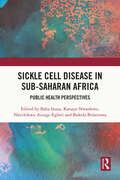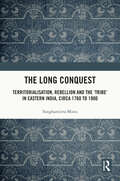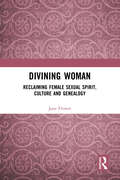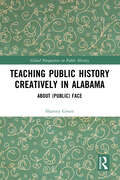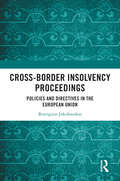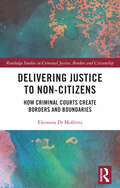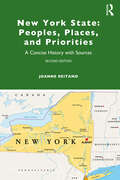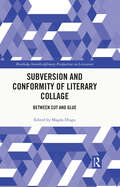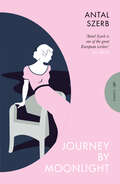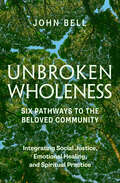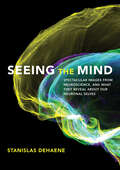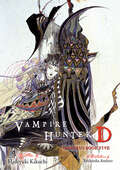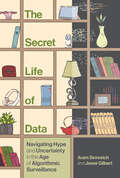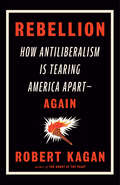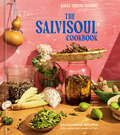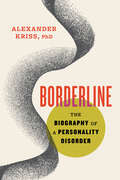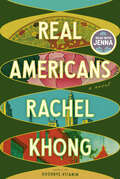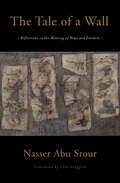- Table View
- List View
Sickle Cell Disease in Sub-Saharan Africa: Public Health Perspectives
by Baba Inusa Kanayo Nwankwo Nkechikwu Azinge-Egbiri Bukola BolarinwaThis fascinating collection examines the socio-economic factors that impact the well-being of patients with sickle cell disease (SCD) in Sub-Saharan Africa and the critical importance of patient advocacy in the region.The book looks at a number of key issues, including the social determinants that influence the spread of the disease, the quality of life of children with SCD, the impact of stigma and the broader psychosocial burden of such a prevalent condition. There are also chapters on policy and Public Health management, including collaborations with non-governmental organisations (NGOs) and global partners.The second in a two-volume set offering a multi-disciplinary perspective on SCD, this insightful collection highlights many of the hidden issues faced across the region. It will be important reading for students of both Public Health and Medicine, as well as practitioners working for governments or NGOs.
The Long Conquest: Territorialisation, Rebellion and the 'Tribe' in Eastern India, circa 1760 to 1900
by Sanghamitra MisraThis book is an enquiry into the elision of the figure of the sovereign, cotton-producing Garo in the colonial archive and its savage transformation into imperialism’s quintessential ‘primitive’ in the period between 1760 CE and 1900 CE.The precolonial political economy of hill cotton produced by the Garos, its unhinging from the exercise of Garo sovereignty and its eventual commodification twined with the deterritorialization of the community as it made way for elephant mehals and reserved forests form the kernel of the book. This history is seen as participating in and mirroring analogous processes of colonization across vast contiguous swathes of India, including Mymensingh, Chittagong, Bhagalpur, the Khasi hills and the Cachar valley. A central theme explored is the long history of Garo rebellions and their rationality, examined in conjunction with contiguous polities such as that of the Khasis; even as the book follows the growing arc of colonial power in eastern and northeastern India as it converted territory and revenue appropriated through conquest, into dominium.The book makes an original contribution to the historiography of the colonial state, the ‘tribe’ and primitivism by making a case for the welded histories of war, ethnogenesis, revenue extraction and anthropological knowledge otherwise often studied as disparate fields of scholarship. It therefore also offers a new interpretation of the history of the colonization of eastern and northeastern India. The book will be of interest to academics and researchers of these regions and of empire and political economy, law and ‘primitivism’, and anthropology and colonial revenue.
Divining Woman: Reclaiming Female Sexual Spirit, Culture and Genealogy
by Jane FlowerDivining Woman is directed to both the academic for research praxis and general reader interested in female history. It takes the reader on a historical journey from the rise of patriarchy and its grand narratives that defined the place of women in western culture and which still resonate today. At the same time is the lesser, but extremely interesting history of a contemporary woman as she navigates the place of one woman in today’s world and how the reader might evaluate their own place as a creative force in reclaiming her voice, culture and lineage today. The author takes a systemic approach in her research that introduces a different history of certain women throughout time, with their specific characteristics and skills, as well as their impactful actions. It is a reclamation of female culture and a newfound history of female genealogy within a framework that covers the female spiritual in Celtic, Christian, Buddhist and the secular arts. The in-depth research, historical and cultural interplay, literary quests and myths promote a compelling case of women’s fight against subjugation and exclusion.This is both academic research and feminist storytelling intertwined with historical events that provide the reader with a creative insight into the topic. On one hand, academic research and analysis style gives an overview of patriarchy and its effects, past and present, and on the other. The first-person narration, personal anecdotes and storytelling help bring Divining Woman to life. Content is thus enhanced and complemented by these two styles. This thesis places the reader in a prime position to launch the young academic on the road to finding solutions ‘outside’ the mainstream schools of thought – because it is honest, personable and thoroughly academically researched.
Teaching Public History Creatively in Alabama: About (Public) Face (Global Perspectives on Public History)
by Sharony GreenThis book chronicles a University of Alabama historian’s efforts to engage public history over the course of a decade, highlighting personal and educational experiences inside and outside of the classroom.Each chapter reveals how Sharony Green, her students, and collaborators used various public places and spaces in Alabama, including the University of Alabama and Tuscaloosa, where she teaches, as “labs” to learn more about our shared past. Inspired by her familiar beginnings in a historic community in Miami, Florida, the author, a descendant of people from the American South and the Bahamas, unveils her encounters with the built environment, old documents and objects, motion pictures, music, and all kinds of historical actors. The book shares a variety of projects including exhibits and displays, images, videos, songs, and poetry, that serve as manifestations of her encounters with the places around her and her students. Together, these stories uncover an unexpected journey into public history, offering new ways to think about the field and humanities more generally.Teaching Public History Creatively in Alabama is an enlightening resource to both intentional and unintentional practitioners of public history, including scholars, students, and general readers interested in connecting with the past.
Cross-Border Insolvency Proceedings: Policies and Directives in the European Union
by Remigijus JokubauskasThis book presents an analysis of the effectiveness of European Union cross-border insolvency proceedings. It provides a thorough assessment of the development of cross-border insolvency proceedings established in the Regulation on Insolvency Proceedings ((EU) 2015/848) and how they contribute to the general goals of the EU internal market. Insolvency law has not been subject to a global mandatory harmonization process, with no globally biding legal act. Instead, the landscape of international insolvency law is characterized by a patchwork of national laws that seek to accommodate cross-border insolvencies and soft law agreements. In the EU cross-border insolvency law holds significant importance in ensuring the smooth operation of the internal market. Fostering international investments and legal foreseeability in insolvency proceedings, it upholds the fundamental freedoms within EU law. This book covers the main elements of EU cross-border insolvency law, such as jurisdiction, applicable law, recognition and enforcement of judgments. It also focuses on previously unexplored areas, such as the exercise of creditors' rights in cross-border insolvency cases and the tracing and recovery of assets and discusses the application of the Restructuring and Insolvency Directive ((EU) 2019/1023) in relation to the rescue of viable companies and the discharge of debts for insolvent entrepreneurs. This book will be of interest to students and practitioners of insolvency law, EU law and private international law. It will also be useful for national legislators and EU institutions working on the development of EU insolvency law.
Delivering Justice to Non-Citizens: How Criminal Courts Create Borders and Boundaries (Routledge Studies in Criminal Justice, Borders and Citizenship)
by Eleonora Di MolfettaHow does justice for non-citizens look like? This book provides a nuanced cross-section of how criminal courts deliver justice to non-citizens, investigating rationales and purposes of penal power directed at foreign defendants. It examines how lack of citizenship alters the contours of justice, creating a different system oriented at control and exclusion of non-members. Drawing on ethnographic research in an Italian criminal court, the book details how citizenship and national belonging not only matter, but are matters reproduced, elaborated, and negotiated throughout the judicial process, exploring the implications of this development for the understanding of penal power and the role of criminal courts.Set in the context of the growing intersection between migration control and penal power, Delivering Justice to Non-Citizens explores whether and how instances of border control have seeped into judicial practices. In doing so, it fills a significant gap in the scholarship on border criminology by considering a rather unexplored actor in the field of migration studies: criminal courts. Based on a year of courtroom ethnography in Turin, Delivering Justice to Non-Citizens relies on interviews with courtroom actors, courthouse observations, analysis of court files, together with local media analysis, to provide a vivid image of judicial practices towards foreign defendants in a medium-size criminal court. It considers and balances the distinctive traits of the local context with ongoing global processes and transformations and adds much needed insights into how global processes impact local realities and how the local, in turn, adjusts to global challenges. Through instances of everyday justice, the book calls attention to how migration control has silently seeped into the judicial realm.The book will be of interest to students and academics in sociology, criminology, law, penology, and migration studies. It will also be an important reading for legal practitioners, magistrates, and other law enforcement authorities.
New York State: A Concise History with Sources
by Joanne ReitanoNow in its second edition, New York State: Peoples, Places, and Priorities is an accessibly written book that explores the ever-shifting dynamics of New York State history in a single volume.The text is organized both chronologically and topically, balancing political, economic, social, and cultural history. It discusses key figures, groups, movements, and controversies, upstate and downstate. Each chapter is divided into teachable, digestible sections that examine the major developments and challenges of that period, with timelines and lists of online resources to aid student understanding. The new edition brings New York State’s history into the present with coverage of recent political and economic developments, the Covid-19 pandemic, immigration, and global warming. Throughout the book, material was added concerning the American Revolution, the Civil War, women’s rights, and environmental justice. Artwork, maps, charts, and textboxes illuminate the state’s rich history. Analytical questions accompanying figures and texts encourage deeper engagement with the past.Designed for undergraduates, this book is a concise and updated account of New York State’s history over the centuries, with a wealth of resources to benefit students and instructors alike.
Subversion and Conformity of Literary Collage: Between Cut and Glue (Routledge Interdisciplinary Perspectives on Literature)
by Magda DraguSubversion and Conformity of Literary Collage: Between Cut and Glue fills a gap in the current scholarship on literary collage, by addressing how different the interpretations of the concept are, depending on the author who uses the concept and the material and writers surveyed. The book studies writers who employed literary collage during the twentieth and twenty-first centuries, some whose works have been intensely analyzed from this perspective (William S. Burroughs and Walter Benjamin), but also some whose collage-writing style has recently been investigated by writers, being usually placed under the umbrella term of artist books (Stelio Maria Martini).
Journey by Moonlight (Pushkin Press Classics)
by Antal SzerbAn early-twentieth-century classic — the turbulent, dreamlike story of a businessman torn between middle-class respectability and sensational bohemia&“No one who has read it has failed to love it.&” — Nicholas LezardMihály and Erzsi are on honeymoon in Italy. Mihály has recently joined the respectable family firm in Budapest, but as his gaze passes over the mysterious back-alleys of Venice, memories of his bohemian past reawaken his old desire to wander.When bride and groom become separated at a provincial train station, Mihály embarks on a chaotic and bizarre journey that leads him finally to Rome, where he must reckon with both his past and his future. In this intoxicating and satirical masterpiece, Szerb takes us deep into the conflicting desires of marriage and shows how adulthood can reverberate endlessly with the ache of youth.
UNBROKEN WHOLENESS: Integrating Social Justice, Emotional Healing, and Spiritual Practice
by John Bell&“A holistic vision breathtaking in scope.&”—Frances Moore LappéDistilling a lifetime&’s insights on the triangle of healing emotional pain, social justice work, and spiritual growth, veteran activist and educator John Bell shares personal stories and reflective practices to help us on our path of personal and collective transformationUnbroken Wholeness brings an integrated lens of social justice, trauma healing, and spiritual practice to the work we do in the world and the pressing concerns of our times.Collectively, these writings help us access a view of the world as unbroken, even in the face of obvious suffering and disharmony. With searching questions and easy-to-follow practices, Unbroken Wholeness offers a way for activists to apply mindfulness and insight to bring about healing for seemingly intractable social divisions. &“Skillfully handling our emotional pain about the world while cultivating a joyful and kind heart helps us navigate the troubled waters of our life,&” says John Bell. Continuing the peace work of his teacher, the Vietnamese social activist and Zen master Thich Nhat Hanh, John Bell brings forward the importance of cultivating a practical yet visionary, ennobling view of humankind when engaging in the &“mud&” of daily difficulties that gives rise to the lotus of an enlightened, compassionate heart.
Seeing the Mind: Spectacular Images from Neuroscience, and What They Reveal about Our Neuronal Selves
by Stanislas DehaeneA lavishly illustrated and accessibly explained deep dive into the major new findings from cognitive neuroscience.Who are we? To this age-old question, contemporary neuroscience gives a simple answer: we are exquisite neuronal machines. Each of our dreams, thoughts, and feelings arises from a pattern of activity in our brain. In Stanislas Dehaene&’s Seeing the Mind, we learn not only that the mind maps onto the brain, but that it is just a complex electrical motif on the tapestry of our neurons. In this richly illustrated and highly accessible book, Dehaene uses the power of brain images to tell the story of centuries-old efforts to understand who we are, and how it is possible that our thoughts emerge from just three pounds of flesh. Seeing the Mind is divided into one hundred topics, each described by a spectacular full-page color image and, on the facing page, a brief text that explains what this image means and why it matters. By weaving together images and text, the book brings readers into the intimacy of their own brains. As Dehaene explains, &“All the gorgeous biological processes that you are about to discover are taking place, right now, inside your own brain.&” A modern cabinet of curiosities, Seeing the Mind is an intriguing and memorable read that will astonish readers with a direct, face-to-face meeting with themselves—and with the material stuff of their thoughts and dreams.
Vampire Hunter D Omnibus: Book Five
by Hideyuki KikuchiA new omnibus collecting volumes thirteen, fourteen, and fifteen of the Vampire Hunter D horror novel series!The hunt continues in the bizarre far future of 12,090 A.D, where the immortal vampire lords who were the only winners of mankind&’s nuclear war still oppress the human survivors who have pushed the blood-drinking fiends back to the lawless Frontier. Yet humanity too remains as quick as ever to prey upon itself, and where the law can&’t bring safety or justice, the crescent blade of D will—assuming you meet the half-vampire wanderer&’s price!Vampire Hunter D Omnibus Book Five collects in full two different multi-part novels!Twin-Shadowed Knight is a story in two parts—most apt, as the D&’s investigation into a vampire&’s dying words leads to a sorcery that splits the Hunter himself into two beings…the second D, full of passion, hunger, and carnal desire!Then, the three-part Dark Road brings triple the thrill, as D crosses over the southern border into the realm of General Gaskell. No ordinary vampire noble, this immortal warlord survived his supposed death under the sun to command the loyalty of a veritable army of the undead, who have been given their silent marching orders—eliminate D! The Vampire Hunter D Omnibus Book Five collects volumes 13, 14, and 15 in author Hideyuki Kikuchi&’s adventure horror series: Twin-Shadowed Knight Parts One and Two, Dark Road Parts One and Two, and Dark Road Part Three. Illustrated by Final Fantasy artist Yoshitaka Amano, the legend of D endures!
The Secret Life of Data: Navigating Hype and Uncertainty in the Age of Algorithmic Surveillance (The Information Society Series)
by Aram Sinnreich Jesse GilbertHow data surveillance, digital forensics, and generative AI pose new long-term threats and opportunities—and how we can use them to make better decisions in the face of technological uncertainty.In The Secret Life of Data, Aram Sinnreich and Jesse Gilbert explore the many unpredictable, and often surprising, ways in which data surveillance, AI, and the constant presence of algorithms impact our culture and society in the age of global networks. The authors build on this basic premise: no matter what form data takes, and what purpose we think it&’s being used for, data will always have a secret life. How this data will be used, by other people in other times and places, has profound implications for every aspect of our lives—from our intimate relationships to our professional lives to our political systems.With the secret uses of data in mind, Sinnreich and Gilbert interview dozens of experts to explore a broad range of scenarios and contexts—from the playful to the profound to the problematic. Unlike most books about data and society that focus on the short-term effects of our immense data usage, The Secret Life of Data focuses primarily on the long-term consequences of humanity&’s recent rush toward digitizing, storing, and analyzing every piece of data about ourselves and the world we live in. The authors advocate for &“slow fixes&” regarding our relationship to data, such as creating new laws and regulations, ethics and aesthetics, and models of production for our data-fied society.Cutting through the hype and hopelessness that so often inform discussions of data and society, The Secret Life of Data clearly and straightforwardly demonstrates how readers can play an active part in shaping how digital technology influences their lives and the world at large.
Rebellion: How Antiliberalism Is Tearing America Apart--Again
by Robert KaganA chilling and clear-eyed warning about the threats to our democracy posed by the increasing radicalization of the Republican Party, from a leading historian and intellectualThe 2024 election could be the last free election held in a unified America. So warns Robert Kagan in this brilliant and terrifying analysis of the perilous state of democracy in the United States today. If Donald Trump loses the upcoming election, as he did in 2020, but refuses to accept the result, as he also did in the last election, he is likely to call on his millions of followers to repudiate the election results. It will be a short step from there to Republican-dominated states rejecting the legitimacy of the federal government and effectively seceding. The United States at that point will cease to be united, with grave consequences for both Americans and the world.In Rebellion, Kagan dives deeper than the op-eds and think pieces to explore the historical forces that have brought us to this moment—in particular the long history of opposition to liberalism, and to government, that has shaped America&’s character from the time of the Revolution to today. Trump&’s unique capacity to tap into that tradition of dissent and circumvent the American system has brought us to the edge of dissolution—not for the first time in our history but possibly the last. This is an elegant and deeply informed synthesis of history, contemporary politics, and ideas that sheds light on this crucial moment.
The SalviSoul Cookbook: Salvadoran Recipes and the Women Who Preserve Them
by Karla Tatiana VasquezA beautifully photographed cookbook that celebrates the vibrant culture and community of El Salvador through 80 recipes and stories from twenty-five Salvadoran women.&“A heartfelt tribute to heritage, a testament to the power of storytelling, and an invitation to savor the true essence of El Salvador, one delicious recipe at a time.&”—Hawa Hassan, James Beard Award–winning author of In Bibi&’s KitchenIn search of the recipes and traditions that made her feel at home, food historian and Salvadoran Karla Tatiana Vasquez took to the internet to find the dishes her mom made throughout her childhood. But when she couldn't find any, she decided to take matters into her own hands. What started as a desire to document recipes turned into sharing the joys, histories, and tribulations of the women in her life.In this collection of eighty recipes, Karla shares her conversations with moms, aunts, grandmothers, and friends to preserve their histories so that they do not go unheard. Here are recipes for Rellenos de Papa from Patricia, who remembers the Los Angeles earthquakes of the 1980s for more reasons than just fear; Flor de Izote con Huevos Revueltos, a favorite of Karla's father; as well as variations on the beloved Salvadoran Pupusa, a thick masa tortilla stuffed with different combinations of pork, cheese, and beans. Though their stories vary, the women have a shared experience of what it was like in El Salvador before the war, and what life was like as Salvadoran women surviving in their new home in the United States.
Borderline: The Biography of a Personality Disorder
by Alexander KrissAn intimate, compassionate, and expansive portrait of Borderline Personality Disorder that rejects the conventional wisdom that the condition is untreatable and those diagnosed with it are &“difficult,&” told by a psychologist who specializes in BPDMental illness is heavily stigmatized within our society, and folks with BPD are portrayed as especially hopeless by doctors and popular culture alike. When, as a graduate student, Alexander Kriss first began working as a therapist in the field, his supervisors warned him that borderline patients were manipulative and had a tendency to drop out of treatment. Yet, years later, when Kriss was establishing his private practice and a patient named Ana came to his office, he felt compelled to try to help her, despite all of the warnings he'd heard.Borderline is the story of his work with Ana—how their relationship led Kriss to a deeper understanding of the borderline experience and what it means to be a person. Borderline is also the story of the disorder itself—Kriss traces accounts of the condition going back to antiquity, showing how this diagnosis has been known by many names over the millennia, most of them gendered: witchcraft, hysteria, moral insanity. All referred to a person—usually a woman—whose behavior and personality were seen as unstable, unpredictable, and uncontrollable. Kriss illustrates the pivotal role borderline patients played in the invention of psychotherapy, the development of modern psychology and psychiatry, and current attitudes about what it means to be healthy. Through the interweaving of personal and global histories, he ultimately argues that BPD is the most important diagnosis of our time: the individual expression of cultural angst that emerges out of systemic inequality, the fracturing of narratives, and our collective search for meaning and identity.
Real Americans
by Rachel KhongReal Americans begins on the precipice of Y2K in New York City, when twenty-two-year-old Lily Chen, an unpaid intern at a slick media company, meets Matthew. Matthew is everything Lily is not: easygoing and effortlessly attractive, a native East Coaster, and, most notably, heir to a vast pharmaceutical empire. Lily couldn't be more different: flat-broke, raised in Tampa, the only child of scientists who fled Mao’s Cultural Revolution. Despite all this, Lily and Matthew fall in love. <P><P> In 2021, fifteen-year-old Nick Chen has never felt like he belonged on the isolated Washington island where he lives with his single mother, Lily. He can't shake the sense she's hiding something. When Nick sets out to find his biological father, the journey threatens to raise more questions than it provides answers. <P><P> In immersive, moving prose, Rachel Khong weaves a profound tale of class and striving, race and visibility, and family and inheritance—a story of trust, forgiveness, and finally coming home. <P><P> Exuberant and explosive, Real Americans is a social novel par excellence that asks: Are we destined, or made? And if we are made, who gets to do the making? Can our genetic past be overcome? <p> <b>New York Times Bestseller</b>
The Tale of a Wall: Reflections on the Meaning of Hope and Freedom
by Nasser Abu SrourThis passionate autobiography—at once history lesson, prison memoir, metaphysical inquiry, love story, and cry for justice—provides insights into the Israeli occupation and the struggle of the Palestinian people.One of more than 5,000 Palestinians held in Israeli prisons before October 7, 2023, Nasser Abu Srour serves a life sentence with no possibility of parole. From the Nakba to the disastrous consequences of the Oslo Accords, he explains with great acumen how the Intifada of the Stones (1987–1993) ultimately provided the only option for young Palestinians in refugee camps to infuse meaning into their lives, especially as they faced a constant threat of humiliation and manipulation by Israeli intelligence. This uprising leads to Abu Srour&’s incarceration, after he was forced to confess, under torture, to involvement in the killing of a Shin Bet officer who recruited his cousin as an informant.Within his cell, Abu Srour turns the Wall that has deprived him of freedom into his interlocutor and the source of stability that allows him to endure a chaotic, hopeless existence. The limitations of this survival strategy—and singular literary device—become painfully evident when falling in love causes Abu Srour to lose his grip on the Wall. Only by writing the story of his imprisonment and the story of his love does Abu Srour find his way back. In doing so, he has created a work of art that transcends his pain while shining a glaring light on the ongoing tragedy of the Palestinian situation.
Mrityu ke baad ka din: मृत्यु के बाद का दिन
by Nikhil Kushwahaयह पुस्तक, जैसा कि नाम से संकेत मिलता है, एक आत्मा के अनोखी यात्रा की कहानी है। एक कॉरपोरेट कंपनी के लिए काम करने वाला अर्पण अपने जीवन में बहुत व्यस्त है। अपनी नौकरी के अलावा उसे किसी की कोई परवाह नहीं, न ही उसकी पत्नी, भाई और न ही उसकी बेटी की। उसके लिए मूल्यवान है तो बस पैसा और उसके दोस्त व सहयोगी। और तो और वह एक नास्तिक भी है जिसे ना तो इस्वर में विश्वास है, ना तो कर्म या भाग्य मे। मृत्यु जीवन की ही तरह एक सच्चाई है, और एक दिन यह हमारे लिए अवश्य आएगा, लेकिन सवाल यह है कि कब। ये अब से दशकों बाद भी आ सकता है या कल भी। क्या होगा अगर हमारी मृत्यु कल हो गयी तो? हम सभी के पास कई योजनाएं हैं जैसे स्वस्थ योजना, सेवानिवृत्ति योजना, पर क्या हमारे पास मृत्यु की कोई योजना है? जीवन पश्चात हम कहां जाएंगे, किससे मिलें? मृत्यु के बाद का जीवन क्या है? इस कहानी में अर्पण हमारे जीवन के सबसे महत्वपूर्ण प्रश्नो के उत्तर की खोज करेंगे। वे उस दूसरी दुनिया के अनसुलझे रहस्यों का पर्दाफास करेंगे, हमें मौत के बाद की यात्रा कराएँग।
Namaste Bharat: नमस्ते भारत
by Manu Manojभारत का इतिहास कई सुनहरी गाथाओं को संजो कर रखे हुए है जो आज भी मानवता के लिए प्रेरणा हैं। उपनिषदों और दर्शन में भारतीयों का चिंतन उत्कृष्ट कोटी का है। कई महान व्यक्ति इस धरती पर पैदा हुए हैं जिन्होने सम्पूर्ण मानवता के लिए ज्ञान के नए द्वार खोले हैं। वैश्विक स्तर के कई महाविद्यालय इस धरती पर हुआ करते थे और नमस्ते भारत नाम का यह उपन्यास इस सुनहरे इतिहास को देखने का मात्र एक प्रयास है।
Kulvruttant: कुलवृत्तांत
by Narayan Dharapमानव स्वत:च्या उत्क्रांतीचा कधी विचार तरी करतो का? आपण कोण होतो, कोठून आलो, कोठे चाललो आहोत, या प्रवासाची परिणती कशात होणार आहे याचा माणूस कधी विचार तरी करतो का? मी तरी कोण? येथे या शहरात कसा आलो? प्रत्यक्ष मी नाही; पण माझे पूर्वज... कोठून आले? महत्त्वाकांक्षेने आले की, गरजेपोटी आले? मी अनेक कुलवृत्तांत वाचले होते. चारचार, पाचपाच पिढ्यांचा इतिहास. त्यात एका तक्त्याच्या रूपात मांडला होता. आडव्या उभ्या रेषांनी जोडलेली ती फक्त नावं होत. अमक्याची ती चार-पाच मुलं... त्यांचे विवाह... त्यांची मुलं... हा नावांचा आणि रेषांचा तक्ता त्यांच्या खऱ्या आयुष्याबद्दल काय सांगणार? त्या तर फराट्यांनी ओढलेल्या रेषाकृती होत्या; पण माझ्या विलक्षण अनुभवात या रेषाकृती सजीव झाल्या होत्या. रंग... रूप... सुखं... दु:ख... अशा सगुण त्रिमित स्वरूपात समोर आल्या होत्या... रोजच्या व्यवहाराच्या चौकटीत हा असाधारण अनुभव बसवणं किती कठीण होतं! जवळजवळ अशक्यच! पण इथे धोका होता. त्या कालगर्तेत माझा प्रवेश अगदी सहज होत होता. पण काही कारणाने, अपघाताने, दुर्दैवाने मला परत माझ्या एकवीसाव्या शतकात परत येता आलं नाही तर? मी कालवस्त्राच्या त्या सुरकुतीत अडकून पडलो तर? सर्व शक्यतांचा विचार करायला हवा...
Dvait: द्वैत
by Narayan Dharapखर सूर्यप्रकाशात दिसणार्या पावसाळ्यात धूक्याने आच्छादलेले शिखर आपल्याला खुणावतात. कारण धूक्याच्या आवरणामुळे त्यांना रहस्यमय बनवलेले असते. मानवी जडणघडण अशी असते की, त्याला नेहमीच अर्धवट दिसणार्या गोष्टींवरील पडदा उघडून त्यांचे गूढ जाणून घेण्याचा थरार अनुभवायचा असतो. हा नियम केवळ भौतिक जगतालाच लागू पडतो. असे नाही तर अगोदर, अपार्थिव जगातील गोष्टींबाबतही तितकाच लागू पडतो. मानवी मनाचे हे वैशिष्ट्य गेल्या शतकातील ख्यातमान लेखक श्री नारायण धारप यांनी अचूकपणे हेरले आणि उत्कंठावर्धक आणि अकल्पित, रहस्यमय कथांचा मनोवेधक नजराणा वाचकाला भेट दिला. आपल्याला माहीत नसलेल्या अनुभवापलीकडच्या जगात काय असेल हे जाणून घेण्याच्या आपल्या उत्कट इच्छेला ते हळूवारपणे फुंकर घालून फुलवतात. त्यांच्या कथांमधून आपल्याला अपेक्षित नसलेल्या, आपल्याला कल्पनाही करता येणार नाही अशा घटना एकापाठोपाठ वेगाने घडू लागतात आणि आपला या जगाशी असलेला संबंध तात्पुरता तुटतो. आपण त्या काल्पनिक जगात इतके गुरफटले जातो की, पुस्तक पूर्ण वाचून बाजूला ठेवेपर्यंत एका अनोख्या विश्वाचा भाग बनून जातो. धारपांच्या द्वैत या कादंबरीतील ठेंगू खलनायक अशीच वाचकांची उत्कंठा वाढवत जातो. कादंबरीतील विविध पात्रांच्या दृष्टिकोनातून आपल्याला एकूण घटनाक्रमांचे विविध पैलू दिसत जातात. पाप आणि पुण्य या कल्पना अमूर्त आहेत, ॲजबस्ट्रॅक्ट आहेत; पण पापी स्वभाव ही गोष्ट खरी आहे, कारण ती एक घटना आहे. त्यामागे माणसाचा स्वभाव आहे आणि किंवा नसेलही; पण निसर्ग मात्र माणसाचा स्वभाव अवश्य कोरून ठेवतो आणि तोही कपाळासारख्या अशा एखाददुसर्या ठिकाणी नाही, तर शरीरातल्या प्रत्येक पेशीवर हा साचा उठवलेला असतो. क्रोमोसोमच्या रंगसूत्राची शृंखला आणि त्यातले जीन्सचे दुवे - त्यांच्यातच हे रहस्य दडलेले असते.
Grass: ग्रास
by Narayan Dharapनारायण धारप हे नाव आताच्या वाचन करणाऱ्या पिढीला नवीन असलं तरीही त्यांच्या `ग्रास' या पुस्तकातील तारणगावातील उत्तमचंदाचं पिशाचरूप कसं भंडावून सोडतं, कथानकात पुढे काय घडणार याची उत्सुकता कायम ठेवत वाचकाला कसं गुंतवून ठेवायचं याची प्रचीती त्यांच्या रहस्यमय लेखनातून येते.
Tom Sawyerchi Sahasa: टॉम सॉयरची साहसं
by Mark Twainटॉम सॉयरची साहसं ही कादंबरी दीडेकशे वर्षांपूर्वी अमेरिकेत प्रसिद्ध झाली. मिसिसिपी नदीकाठच्या सेंट पीटर्सबर्ग या काल्पनिक गावात राहाणाऱ्या टॉम सॉयर या खोडकर मुलाचं भावविश्व या कादंबरीत उभं राहातं... बालपणीचा निरागसपणा आणि प्रौढ वयातलं वास्तव यांच्यातील तफावत टॉम सॉयरच्या या गोष्टीतून जाणवते. ही तफावत आपणही अनुभवलेली असतेच ना, त्यामुळं भूगोलाचं नि भाषेचं अंतर पार करून ही कादंबरी आपल्याशी संवाद साधते.
Zund: झुंड
by Dr Sharankumar Limbaleझुंड कादंबरी मध्ये दलितांच्या जगण्यातली दाहकता प्रकर्षाने व्यक्त झाली आहे. दलितांच्या भयावह समस्यांनी ह्या कादंबरीचे कथानक गुंफले आहे. ही कादंबरी मुळातच जात आणि मानवी संबंध यावर आधारलेली आहे. मानवी संबंधांचे विविध पैलू आणि जातीचे पदर या कादंबरीत प्रकट झाले आहेत.
